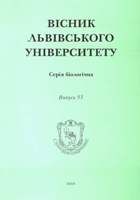

 | Наукова періодика України | 
| Вісник Львівського університету |
Kalinin I. The antioxidant system of tissues of rats poisoned with heavy metals / I. Kalinin // Вісник Львівського університету. Серія біологічна. - 2016. - Вип. 73. - С. 248. - Режим доступу: http://nbuv.gov.ua/UJRN/VLNU_biol_2016_73_58 According to activity on lipid peroxidation and free radical oxidation and level shift the balance between pro-oxidant and antioxidant can be considered objective and very sensitive indicators of overall health, activity and functioning systems maintain homeostasis. These data can provide information about the extent and depth of expression destructive factor action on the body. The antioxidant defense system monitors and inhibits all stages of free radical reactions, from their initiation and ending with the formation of hydroperoxides and malondialdehyde. The main control mechanism of these reactions is associated with the feedback redox reactions of metal ions, glutathione, ascorbate, tocopherol and other substances, the value of which is particularly important for maintaining long-lived macromolecules of nucleic acids and proteins, some components of membranes. There is reason to believe that the life expectancy of macromolecules in a cell is largely determined by their very resistance to the attack of free radical products. Aim of this work was to study the influence of intoxication by heavy metals in the functioning of the antioxidant system in rat tissues. Intoxication copper sulfate leads to an increase of TBA-active products by 40 % in blood and 31 % in the liver, zinc sulfate - 42 % in blood and 31 % in the liver, cadmium sulfate - 66 % in blood and 38 % in liver, lead nitrate - 61 % in blood and 36 % in the liver of animals relative to the control group. After intoxication heavy metal ions increases diene conjugates content in the blood and tissues in rat liver. So blood diene conjugates content increased by 16 % when copper sulfate toxicity, 18 % - zinc sulfate, 24 % - cadmium sulphate, 26 % - of lead nitrate, compared with the control group. The antioxidant defense system monitors and inhibits all stages of free radical reactions, from their initiation and ending with the formation of hydroperoxides and malondialdehyde. Intoxication by heavy metal ions leads to decreased activity of superoxide dismutase and catalase in rat tissues studied, especially when intoxication cadmium and lead ions. In the blood of rats under reduced toxicity of copper sulfate: glutathione peroxidase activity by 22 %, glutathione transferase 47 % and the content of reduced glutathione by 23 %, zinc sulphate - glutathione peroxidase activity by 23 %, glutathione transferase 50 % and the content of reduced glutathione in 27 % of cadmium sulfate - glutathione peroxidase 38 %, glutathione transferase 60 % and the content of reduced glutathione in 34 % of lead nitrate - glutathione peroxidase 34 %, glutathione transferase 57 % and the content of reduced glutathione by 31 %, respectively, compared with the control group of animals. In the context of intoxication with copper sulfate and zinc sulfate glutathione peroxidase and glutathione transferase activity in rat liver varies greatly. Activity in the liver glutathione peroxidase and glutathione transferase conditions for action of cadmium ions is reduced by 25 % and 19 %, respectively, compared with controls. The action of lead glutathione peroxidase and glutathione transferase activity in rat liver decreased by 19 % and 15 %, respectively, compared with control animals. Цитованість авторів публікації: Бібліографічний опис для цитування: Kalinin I. The antioxidant system of tissues of rats poisoned with heavy metals / I. Kalinin // Вісник Львівського університету. Серія біологічна. - 2016. - Вип. 73. - С. 248. - Режим доступу: http://nbuv.gov.ua/UJRN/VLNU_biol_2016_73_58. |
|
|
Всі права захищені © Національна бібліотека України імені В. І. Вернадського |
|||||